Until half a century ago, the library table was the essential piece of furniture in every well-furnished home. Serving the space for both work and study, where they wrote letters and bills, did the family accounts, and read the latest news and novels. These days, the library table has been replaced by the computer desk in most homes.
But, for those who appreciate history and craftsmanship, antique library tables are fulfilling a new role as the centerpiece in living rooms and home offices. If you’re on the hunt for an antique library table (or even better-inherited one) this guide is for you. Let’s look at what makes a library table an antique, ways to identify one, and how to determine its value.
Table of Contents
What’s a Library Table?
Library tables originated from the writing desk in the late 1600s and 1700s. The earliest versions were simple, rectangular desks with four nicely turned legs and one or two small drawers. Each passing decade left its mark; library tables became more grandiose, ornate, and detailed.
For most of their history, library tables remained a luxury item. Only available to the wealthy who could afford a dedicated piece of furniture for reading and writing. Often made of the finest woods like mahogany, walnut, and cherry and customized by the most esteemed furniture makers, library tables were true statement pieces in any home.
By the Victorian Era, library tables reached their height of popularity. Thanks to a flourishing economy, the middle class got the means to buy luxury items. The effect reached far beyond Europe, and library tables began popping up in homes all over America.
You can find many antique library tables from this period in public and private collections worldwide. This increased demand also meant more mass-produced options became available, though they were still not cheap.
The library table remained a popular furniture piece through the Edwardian and Art Deco periods. By the mid-1900s, however, tastes changed, and people began to prefer more functional furniture like coffee tables and TV stands. As a result, the library table fell out of favor and was no longer produced.
With the advent of technology, library tables have been re-imagined as workstations or desks in modern homes. But the charm and elegance of the antique versions are still coveted by collectors and design-savvy homeowners alike.
Identifying Antique Library Tables
During their almost 300-year history, library tables went through many style changes. In each era, artisans put their own spin on the design, construction techniques, materials, and hardware used. Understanding these characteristics can help you to identify and date an antique library table.
With that in mind, here’s a basic guide to help you identify an antique library table:
How to identify an antique library table
1. Determine the Era
Colonial (1680-1770):
American Colonial Era furniture was made by English, Spanish, and Dutch immigrants who brought their skills with them to the New World. It’s a wide period that parallels the Early Baroque era, William & Marry, Queen Anne, and Chippendale styles in Europe. As a result, you’ll see some similarities, but the American versions are far less ornate and have a simpler, functional design.
Library tables from this era are often oak and have straight or turned legs. You’ll see a variety of construction techniques, including dovetailing beginning in the Queen Anne era. Generally, it isn’t easy to come across an authentic piece of furniture from this era. Most of what’s on the market today is from the late 19th century when the styles were reproduced.
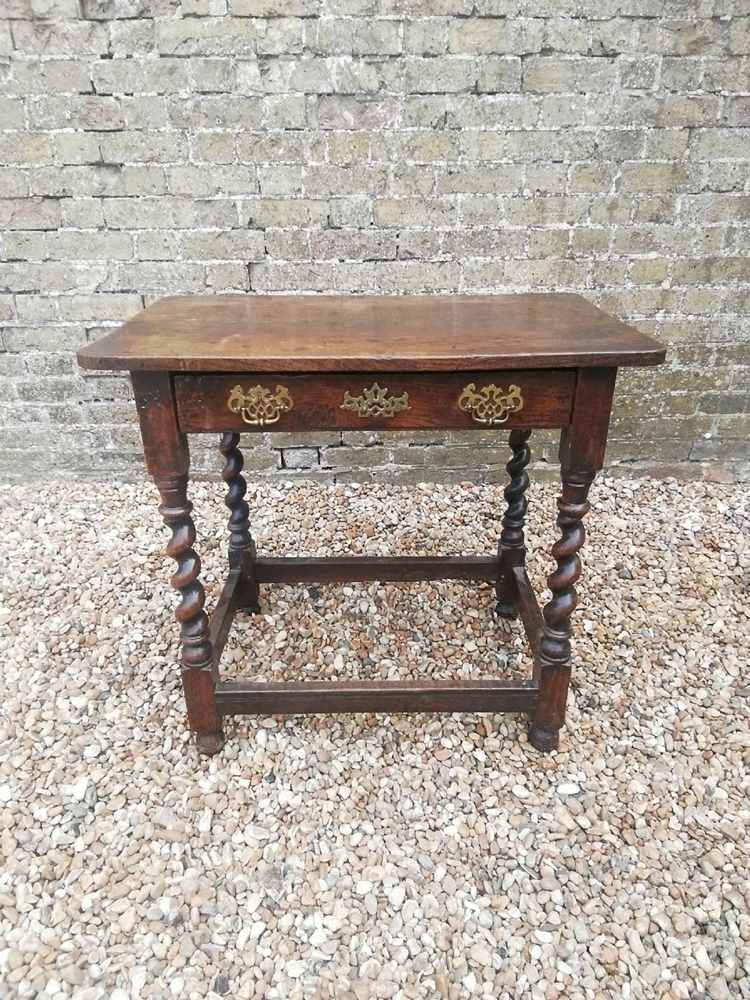
Federal (1780-1820):
The Federal style emerged during the early years of America’s independence. It was greatly influenced by neoclassical French and English trends sweeping through Europe at the time. The look is elegant and refined, with straight lines, symmetry, and muted colors.
You’ll see a lot of straight, slim, tapering legs and a rectangular top. Fine inlay work, veneering, and brass hardware.
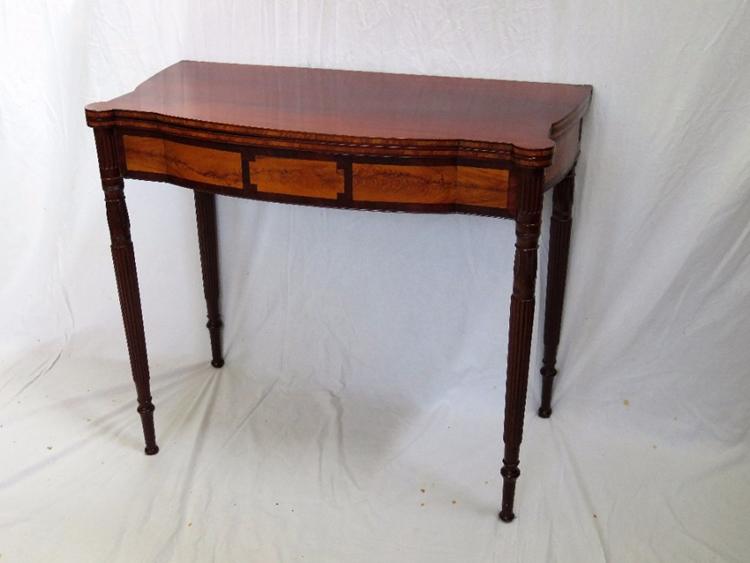
Sheraton (1790-1810):
The Sheraton style emerged during the last years of the Federal period. It is named after English furniture maker Thomas Sheraton. The style is similar to Federal in that it’s elegant and refined, focusing on straight lines and symmetry. But Sheraton furniture is often lighter in appearance with intricate brass hardware.
Dovetailing is the primary joinery method used in Sheraton furniture, and you’ll often see inlay work and hidden drawers. The legs are often straight and less decorated than in other styles from this era.
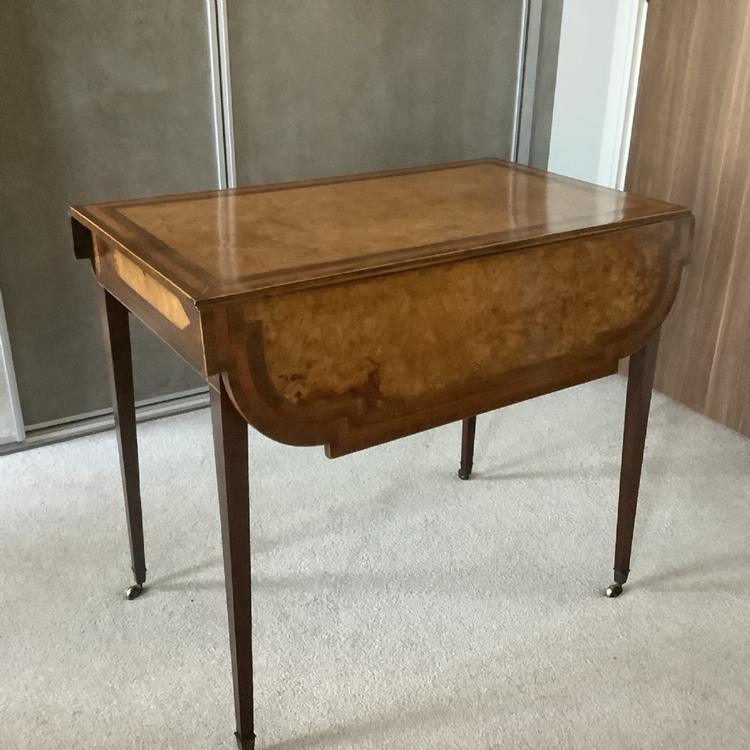
American Empire (1810-1840):
After Napoleon’s conquests in Europe, the second wave of neoclassical design swept the continent. This time around, the look was heavier and more monumental than in any of the earlier styles.
Massive rectangular tops and exaggerated curves characterize library tables from this era. The legs are often curved and decorated with brass or gilt-wood mounts. You’ll also see paw feet, motifs, gilding, and other neoclassical details on Empire time library tables.
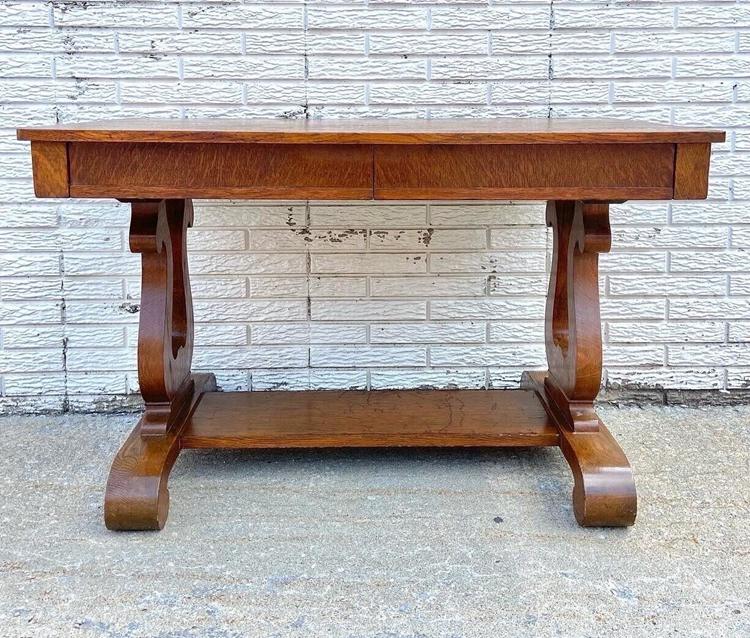
Victorian (1840-1910):
The Victorian era was marked by a dramatic increase in industrialization and a corresponding rise in the middle class. As a result, furniture became more accessible to the general public, and design trends changed rapidly to keep up with the latest fashions.
Many old styles returned during this long period, so you’ll see a lot of furniture that borrows from earlier periods. Gothic Revival, Rococo Revival, Renaissance Revival, and Eastlake are just a few of the styles that emerged during this time. The era also gave birth to the Aesthetic Movement, Art Nouveau, and Arts and Crafts styles, which were a departure from the heavy, ornate furniture of the past.
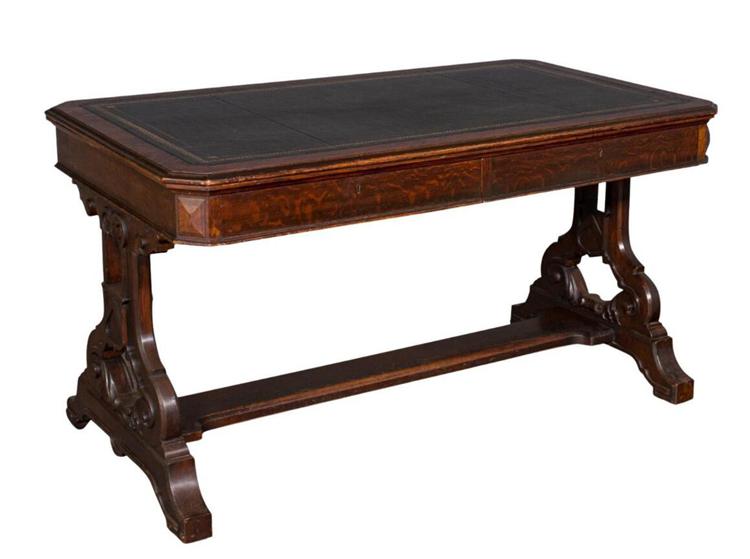
Overall, library tables from the Victorian era tend to be large, heavy, dark, and ornate, with a plethora of carving, inlay work, and other decorations. Leather upholstery, sumptuous fabrics, and brass hardware are also common features.
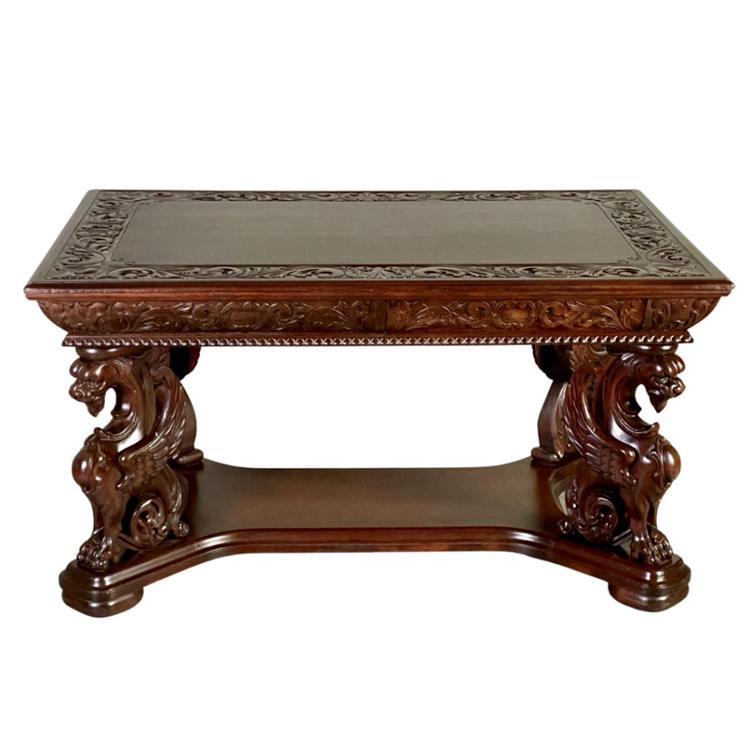
2. Look for Key Characteristics
Designs and trends can often carry over from one era to the next, so you can’t rely on design cues alone to determine the age of a piece. Furthermore, 19th-century revival styles can make it difficult to date a piece accurately.
To narrow down the possibilities, Consider a piece as a whole and look for key characteristics that belong to specific eras. For example:
Construction Techniques:
Until the 1700s, mortise & tenon and miter joining were the most sophisticated joinery methods. The dovetailing method started in the Queen Anne era (1702-1714) and became increasingly common in the late 18th and early 19th centuries. Victorian furniture often uses both dovetailing and mortise and tenon joinery.
However, in later times, nails, screws, and other fasteners became more popular, and machine-made furniture became the norm in the late 1900s. Which is identifiable by perfect symmetries and clean machine-made cuts.
Hardware:
Drawer pulls, locks, and other hardware also offer clues into the age of a piece. For example, in earlier days, brass or cast silver was imported, so the hardware was often more purposeful than ornate. Small trim patterns, mostly floral, are typical of colonial furniture. You can also find Dutch teardrop pulls in Queen Anne furniture.
As you move into the 19th century, hardware becomes more abundant and elaborate. With the advent of mass production in late, the overall metallic mass decreased, but the level of artistry and uniqueness increased.
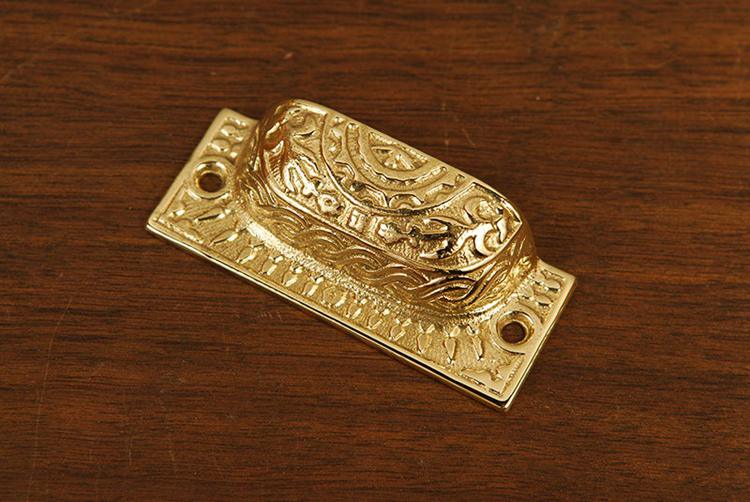
Table Feet:
Several peculiar table leg & feet styles can help you estimate the earliest possible date for a piece. For example, the famous ball and claw feet were popular in Queen Anne and Chippendale styles of the 18th century. Regency-era furniture often has saber or reeded legs, but you’ll also see them in early Victorian ones.
Brand/Manufarurer Label:
Branding became common in the mid-19th century as furniture manufacturers tried to set themselves apart from the competition. And there were just a handful of them, so it’s quite possible to track down the manufacturer if you have the right information. So, if your piece is labeled or stamped by a company from that time, that can give you a good idea of its age.
Here are some notable furniture brands/manufacturers whose labeled pieces can be found in antique stores and online:
- George Hunzinger (1835–1898): One of the most innovative and prolific American furniture designers of the 19th century. He has patented several furniture designs and was the first to use bent wood in American furniture making.
- Herter Brothers (1864–1906): A New York based cabinetmaking firm founded by two German American brothers. They were instrumental in popularizing Eastlake furniture and the Aesthetic moment in America. The red room in the white house is furnished with Herter Brothers furniture.
- J. Horner & Co. (1886–1915): Horner’s specialty was opulent, large-scale furniture. Today Horner pieces are highly sought-after by collectors.
- Mersman Brothers (1876–1995): One of the largest and most prolific American furniture manufacturers of the late 19th century. This Ohio-based company had the biggest share of the tablet market at the time.
- Wolverine Chair and Furniture Co. (1887–1891): A Grand Rapids, Michigan-based company known for their high-quality Stickley style Mission furniture.
If you’re lucky enough to find a piece with a label or stamp, do some research to see if you can pinpoint the date it was made. However, remember that most antique pieces don’t have this information, so don’t get discouraged if you can’t find a label. Your piece may be older or belong to lesser-known brands that didn’t label their products.
Valuing Your Antique Library Table
An antique’s value is more than just its age. Several factors play into how much an antique is worth. Once you’ve determined your piece’s age, look at these other elements to help you ascertain its value.
1- Provenance
This refers to a piece’s history or “pedigree.” If your table was owned by a famous person or passed down through your family for generations, it will be worth more than a similar table without such a history.
However, provenance should be established through supporting documentation such as letters, receipts, or photographs.
For example, the House of Representatives sold Abraham Lincoln’s writing table in 2014 for $120,000
2- Condition
The condition of an antique is crucial to its value. A pristine piece with an original finish will always fetch the best price. However, in the case of furniture pieces, a skillfully done repair or refurbishing is not necessarily a bad thing. Wooden furniture especially needs occasional TLC to stay in good shape. Just make sure you preserve the original features as much as possible.
3- Rarity
It’s a bit harder to qualify rarity, but generally, if a piece is one-of-a-kind or belongs to a limited edition, it will be more valuable. This also includes items made by coveted artists or designers. Original pieces by Hepplewhite, Chippendale, and Stickley can sell for tens of millions of dollars.
A New Jersey teacher sold a rare 18th-century card table for $541,500 in 1998. It was one of the six tables made by famous John Seymour & Son Thomas Chippendale.
4- Workmanship
Early table makers decorated library tables with intricate hand carvings, elaborate inlays, and other Fine hand-made details. Sometimes the level of artistry and the amount of detail outstrip every other factor in terms of value. The highly exquisite and lavish pieces fetch the highest prices.
This 19th-century stunning hand-carved walnut library table by Angiolo Barbetti is listed for &28,817 on eBay.
1st Dibs has this early Victorian era Marquetry work library table priced at $6,479.
Overall an antique library table can cost anywhere from a couple hundred to a few hundred thousand dollars, depending on all the factors mentioned above. Here are a few examples to give you an idea of what you might find and how much it could cost.
1- A simple, 19th-century oak library table with two drawers and heavily turned legs could cost you around $869.
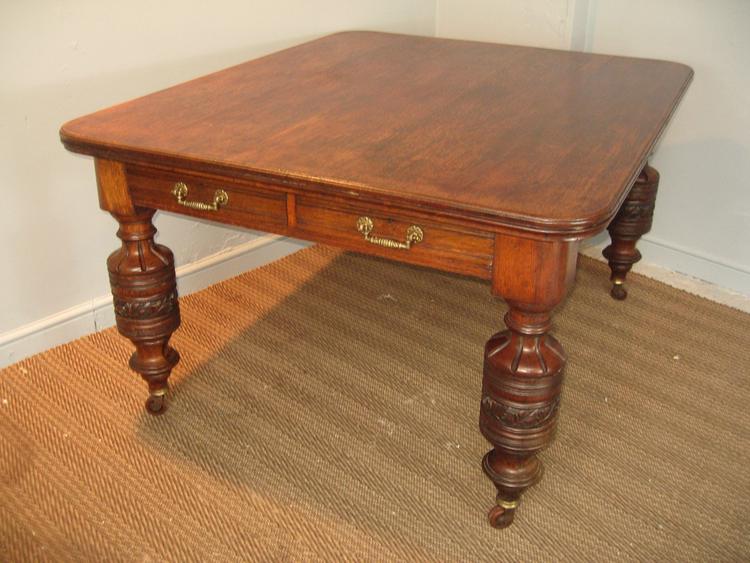
2- If you want something a little more ornate, this Regency period gilt leather top library table costs $6,775.
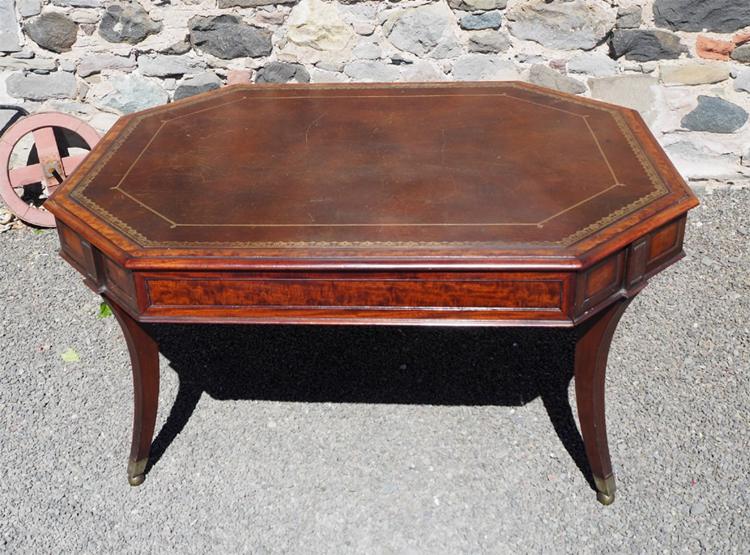
3- A smaller, more delicate Victorian walnut burr library table with a leather top and carved legs. Listed for $1,013.
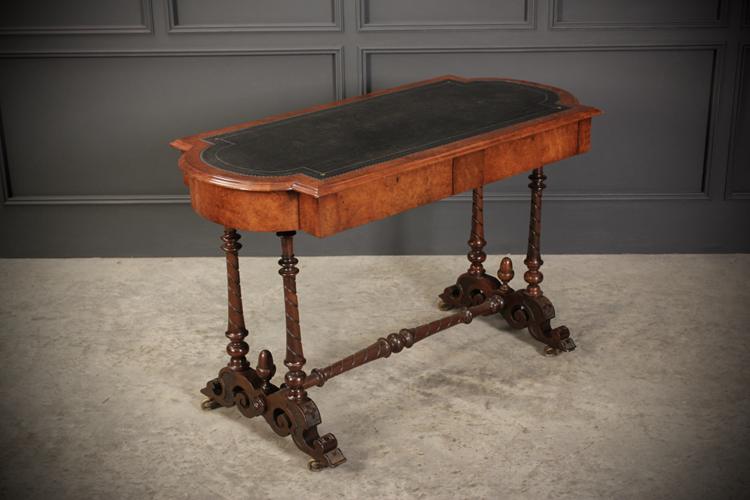
Identifying Counterfeit or Reproduced Antique Library Tables
Even the most well-intentioned antique dealers and furniture restorers can end up with a counterfeit piece in their inventory. A stunning carved walnut table may actually come from a mass-produced 20th-century factory. Or the small victorian table your dealer swore was an original could be a very convincing replica.
Then there are also genuine antique replicas. The mid-19th century ‘Revival era’ copies of 17th and 18th-century furniture, made for the booming Victorian market. These are also difficult to spot and often misattributed to their original period.
So how can you safeguard your investment and ensure you’re getting the real deal?
Here are some tips:
- Every single antique piece was handmade, which means irregularities in the construction. Look at the dovetailing on drawers, for instance – if it’s too perfect, it’s probably a 20th-century machine-made copy. Also, Keep an eye out for hand-cut vs. machine-made screws that were first used in the 1880s.
- An old library table will show inconsistent signs of wear and tear. A few scratches here and there, some uneven fading – these are all good things because it means the piece has been used and loved over the years. If the table looks brand new, or all wear marks are perfectly even, it’s probably a fake.
- Earlier cabinetmakers didn’t use valuable wood in places that would never be seen, like the insides of drawers. So a single table can be a mix of different woods – the cherry on the outside and poplar on the inside, for example. The same goes for the grain finish – it can be different on the different parts of the table.
- Don’t be fooled by an old look. Many furniture pieces are made to look old using a process called ‘distressing.’ This involves artificially creating nicks, dents, and scratches in the wood. Then apply a dark stain to give it an aged appearance. Sometimes it’s an intentional styling like ‘shabby chic.’ But more often than not, it’s just a way to make a new piece of furniture look old and, thus, more valuable.
- The best way to avoid a fake is to buy from a reputable dealer and do your homework. If you’re not sure about something, ask an expert. It’s better to be safe than sorry when investing in antique furniture.
Where to Buy or Sell Antique Library Table?
Library tables are not as common as other types of antique furniture. And if you’re looking for a specific style or period, you may have to put in some extra legwork to find the perfect piece. The same goes for sellers – unless you have a hot item on your hands, it may take some time to find a buyer.
Selling Antique Library Tables
If you’re selling, the best place to start is your local antique dealer or furniture store. They may not be interested in buying your table. But they can inspect the piece in person, give you an idea of what it’s worth, and put you in touch with potential buyers.
Once you’ve got a better idea of the table’s value, you can also try online marketplaces like eBay. These platforms have a global reach and can connect you with buyers from all over the world. For highly sought-after or unique tables; consider an auction house like Sotheby’s or Christie’s. These companies specialize in selling high-end antiques and can help you get the best price for your table.
Buying Antique Library Tables
When buying an antique library table, your best bet is to shop around and compare prices. Check out online marketplaces, and visit brick-and-mortar antique stores & auction houses. You’ll get an idea of what’s available and how much it costs.
Ask the seller to provide as much documentation as possible. Get a detailed table description, photos from different angles, and information about its history or provenance. If you’re buying online, make sure the seller has a good reputation and is willing to answer any questions.
And finally, don’t be afraid to negotiate. With antique furniture, the seller usually has some wiggle room regarding the price. So if you think you can get the table for a lower price, don’t hesitate to make an offer.
Conclusion
Antique library tables are prized for their beauty, artistry, and history. The challenge for a collector is finding an authentic piece in the right style and condition. Luckily, many resources are available online to help you find the perfect table for your collection.
Here are a few takeaways from this article:
- The majority of antique library tables on the market date from the American Colonial period to the Victorian era.
- Antique library tables are distinguished based on era-appropriate design, construction technique, and the maker’s identity.
- The value of an antique library table is based on its condition, provenance, rarity, and workmanship.
- Pay attention to details like hardware, carving, and inlay work. These can help you determine the authenticity of a piece.
- Be aware of the Revival era furniture, when much older styles were reproduced. They’re also considered antique but may not have the same value as an original piece.
- Chippendale, Hepplewhite, and Sheraton are among the most famous table makers of the 18th century. But most of their pieces aren’t stamped.
- George Hunzinger, Herter Brothers, and R. J. Horner are famous American manufacturers of the 18th and 19th centuries. Their labeled pieces are highly sought after.
- When buying an antique library table, get help from a reputable dealer and ask for as much documentation as possible. This will increase your chances of getting a genuine piece.





![Where To Sell Antique Furniture In 2022 [Ultimate Guide]](https://www.jacquelinestallone.com/wp-content/uploads/2022/09/Etsy-Your-Place-To-Buy-And-Sell-All-Things-Handmade-600x450.jpg)


